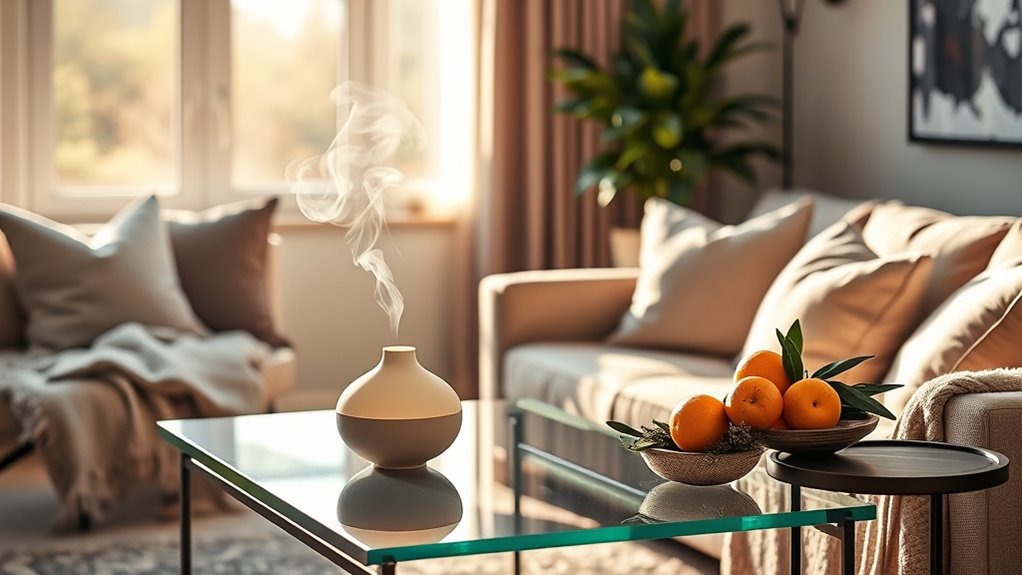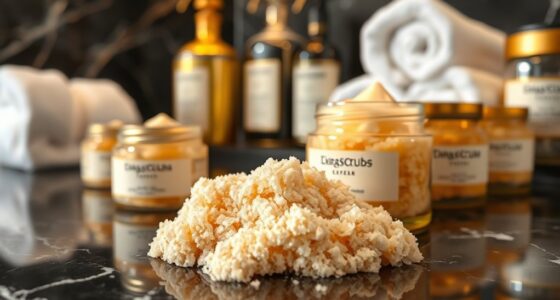To layer fragrances without overwhelming a room, choose lighter products like eau de toilette or body sprays and apply only a small amount—just one or two spritzes—focusing on pulse points like wrists and neck. Avoid rubbing your wrists together and let the scent settle naturally. Consider using scented oils or a subtle body lotion underneath your perfume for added depth. If you keep these tips in mind, you’ll master a soft, inviting scent that leaves a gentle impression rather than overpowering.
Key Takeaways
- Use light, eau de toilette or body spray formulas and limit to one or two sprays for subtlety.
- Apply fragrance on pulse points without rubbing to prevent scent intensification.
- Layer with unscented or lightly scented body lotions and oils as a gentle scent base.
- Be mindful of indoor or enclosed spaces; consider skipping additional scents in small areas.
- Regularly assess and adjust your layering to maintain a personal, understated fragrance profile.

Fragrance layering is an art that allows you to create a unique scent profile by combining different perfumes, body lotions, and oils. It’s a way to express your personality and mood without overwhelming those around you. The key is to strike a balance so that your scent enhances your presence rather than dominates the room. When layering, start with lighter, subtle products, and build gradually. Use a body lotion or oil that has a gentle scent as your base. These products tend to have a softer projection and can serve as a scent canvas for your perfume. Apply the lotion evenly over your skin, focusing on pulse points like your wrists, neck, and behind your ears. This helps your fragrance to meld seamlessly with your body’s natural warmth, releasing a subtle aroma that’s inviting without being overpowering.
Next, choose your perfume carefully. Opt for lighter formulas such as eau de toilette or body sprays rather than heavier, more concentrated scents like parfum or extrait. Spray your perfume from a distance, about 6 to 8 inches away from your skin, to diffuse the scent evenly. Limit yourself to one or two sprays—less is more when you want to avoid overpowering a room. Remember, the goal is to create a gentle aroma that can be detected up close but doesn’t fill the space around you. If you want to add depth, consider using scented oils or a second light fragrance that complements your base scent. Apply these sparingly, focusing on key areas like your wrists or collarbone.
Another tip to keep your fragrance subtle is to avoid rubbing your wrists together after applying perfume. Rubbing can break down the scent molecules and make the fragrance more intense. Instead, gently press your wrists together or let the scent naturally settle. Also, consider your environment—if you’re in a small or enclosed space, opt for even lighter layers or skip additional scents altogether. Remember, the goal isn’t to smell like you just stepped out of a perfume shop but to leave a whisper of fragrance that’s personal and inviting. Regularly assess how your scent interacts with your body chemistry and adjust your layering routine accordingly. Being aware of outdoor environments can help you choose the right intensity for your scent, especially when camping or spending time in natural settings. With practice, you’ll master the art of fragrance layering that’s refined, discreet, and perfectly suited to your style, ensuring you leave a memorable impression without overpowering the room.
Frequently Asked Questions
How Do I Choose Scents That Complement Each Other?
To choose scents that complement each other, start by selecting fragrances with similar notes or families, like floral or citrus. You want scents that blend harmoniously, not clash. Test small amounts first and layer gradually, paying attention to how they evolve over time. Trust your nose—if the combination feels balanced and pleasing, you’ve found a good pairing. Remember, subtlety is key to avoiding overpowering your space.
What Are the Best Times to Layer Fragrances?
Did you know that layering fragrances can boost your scent’s longevity by up to 30%? The best times to layer are right after showering or applying moisturizer, when your skin is still damp. This helps the scents cling better and develop fully. You should also layer in the early evening for a more subtle, sophisticated aroma, avoiding hot, humid days that can intensify fragrances and overwhelm your space.
Can Fragrance Layering Affect Allergies or Sensitivities?
Yes, fragrance layering can affect allergies or sensitivities. When you combine different scents, you might trigger reactions if you’re sensitive to certain ingredients. To avoid this, choose hypoallergenic or gentle fragrances, and test new combinations on a small skin patch first. Keep the layers subtle and avoid overpowering scents, so you minimize the risk of irritation and enjoy your layered fragrances comfortably.
How Long Should I Wait Between Applying Different Scents?
You should wait about 5 to 10 minutes between applying different scents. This allows each fragrance to settle and prevents them from blending too intensely all at once. If you want a subtle layered effect, give each layer enough time to dry slightly before adding the next. Keep in mind, testing your combination on your skin first helps you gauge how long to wait for the perfect, balanced scent.
Are There Specific Ingredients to Avoid in Layered Fragrances?
Think of your layered fragrances as a delicate garden—avoid ingredients like synthetic musks or overpowering spices that can dominate your scent landscape. These elements can turn your subtle harmony into chaos, overwhelming those around you. Stick to natural, balanced notes like citrus, florals, or woods, which blend seamlessly. By choosing ingredients thoughtfully, you’ll create a harmonious aura that’s inviting without becoming overwhelming.
Conclusion
By carefully layering your fragrances, you can create a subtle, inviting scent that enhances your space without overwhelming it. Think of it like a whisper of jasmine paired with a hint of vanilla—delicately balanced and perfectly inviting. Don’t worry about overpowering; start with light touches and build gradually. With a little practice, you’ll craft an ambiance that’s warm and welcoming, making every room feel like a personal oasis, just as you envisioned.









